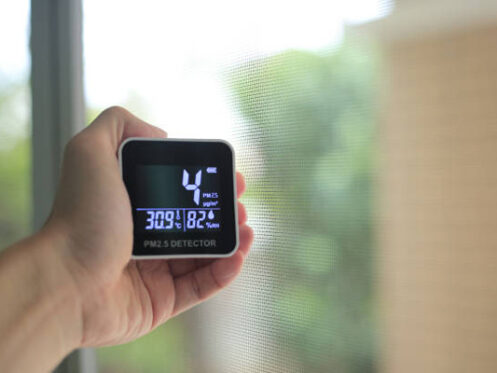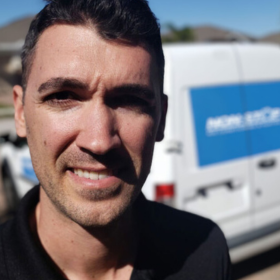Did you know that the amount of some pollutants inside your home can be up to five times higher than outside? It is important to know if the air you and your family are breathing in your home is safe, because indoor air quality and your overall health has clear connections. Even though keeping your carpets clean and changing your air filters often will help, it’s not the only thing you need to do to get and keep good air quality in your home.
Continue reading for some ways on how to keep the air in your home healthy so you and your family can breathe easier and be safe.
Improving and Maintaining Indoor Air Quality
1. Air Quality Testing
Before you do anything to improve the air quality in your home, you should know what you’re up against in your particular environment. Is the air you’re breathing good, bad, or just fine? It’s hard to take the right steps if you don’t know what the problem is and how to fix it. A professional test of the quality of the air inside is a good place to start. After testing, the air quality specialist can tell you how the air quality is and give you ideas on how to fix any problems.
Environmental Protection Agency, also known as EPA, has set their “safe” level exposure standards for most contaminants. These standards focused on the threats to air quality like tobacco smoke. What can be harder to understand is that many of the pollutants that affect the air quality in your home are “off-gas.” This means that they come from products you use around the house, building materials, or supplies you keep at home. VOCs (volatile organic compounds), dust and pollen, formaldehyde, and Radon are some of the most common contaminants found indoors. So, if you don’t have your air checked, you might not know what you’re really breathing or how to make it better.
2. Electric Air Cleaner
When air moves through your home’s heating, ventilation, and air conditioning system, it usually carries a lot of other debris with it, like dust, pet hair, and other small particles. People with allergies can have trouble with these tiny, invisible particles. As part of your home’s heating, ventilation, and air conditioning (HVAC) system, adding an electronic air cleaner that uses electrically charged filters to clean the air can cut down on many of the harmful contaminants that keep coming back into your home.
Most electronic air cleaners have two filters that work together to get rid of harmful particles in the air. The pre-filter traps larger particles such as dust, pollen, and pet hair. Then, the second filter has an electric charge that pulls in and traps smaller microparticles, such as bacteria and mold spores.
If you or someone in your family has allergies, asthma, or other breathing problems, adding an electronic air cleaner to your current heating and cooling system may be one of the best things you can do. These units can also help your HVAC system last longer by reducing the amount of maintenance it needs because of too much dust and dirt. Reusing your electric air filters could help you save time and money.
3. UVC and UVV
Non-Stop Air know that too much ultraviolet light is bad for our skin, but when it comes to the quality of the air, ultraviolet light can be helpful. When used in a closed air filtration system, ultraviolet light has been shown to be very effective at killing microorganisms and stopping them from moving through the ductwork.
UVC, the most powerful type of ultraviolet light, messes up the DNA of microorganisms, which kills them. Because of this, using UVC light in your air filtration system is a great way to improve the quality of the air. Microorganisms don’t get into the air you breathe when they are killed in your ventilation system. This cleans, sterilizes, and disinfects the air in your home, which can help reduce and lessen the effects of allergens in the air.
4. Air Purifiers
Consider buying a whole-house air purifier if you want to improve the air quality in your whole house. Whole-house purifiers help get rid of a lot of the harmful pollutants and contaminants that are floating around in your home’s air. It’s best to have an air purifier for the whole house built into your home’s HVAC system. A built-in unit helps make sure that clean air gets to every part of your home. With a built-in air purifier for the whole house, you won’t have to worry about a big, separate unit taking up valuable floor space.
5. Mechanical Ventilation
Mechanical ventilation systems move fresh air around using ducts and fans. Because it doesn’t rely on the natural airflow that happens when air passes through small gaps in your doors and windows, it helps make sure that fresh air is always coming into your home. It can both filter and remove moisture from the air. This helps improve the quality of the air in your home as a whole by circulating clean, fresh air.
Cape Coral, Florida’s Indoor Air Quality Service Provider
Improving and keeping the air quality in your home may not seem like a pressing problem. But when you think about how much time you and your family spend inside your home, it’s easy to see how bad air quality can hurt your health and well-being.
At Non-Stop Air Conditioning & Heating, we provide excellent indoor air quality services throughout the Charlotte county, Lee county, and Collier county area, including the installation of whole-home residential air purifiers, filtration, and dehumidification systems.
Call Non-Stop Air Conditioning & Heating at (239) 522-8642 today or contact us online to request a free estimate for HVAC cleaning and air quality filtration services.


